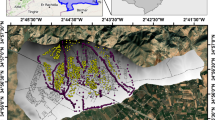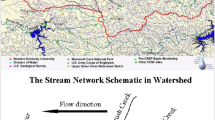Abstract
Landslide displacement evolution is important for predicting landslide geological disasters. Because landslide displacement monitoring data are limited, in this paper we propose a novel model for predicting landslide displacement, namely the kernel grey model with fractional operators (FKGM). By combining the advantages of fractional modeling, kernel function methods and grey models, we derived the theoretical framework of FKGM. The parameters of FKGM were obtained using particle swarm optimization algorithm. Then, FKGM was applied in a case study of a landslide in Hubei, China. The engineering geological characteristics of the landslide were analyzed, and seven factors including rainfall and the rate of the reservoir water-level change were selected as inputs. The results show that the mean absolute percentage error and mean square error of FKGM are smaller than those of the least square support vector machine (LSSVM) and the classical grey prediction model—GM(1,1). The influence of the FKGM parameters was investigated. Our results indicate that FKGM can be applied to reliably predict large deformation of landslides.











Similar content being viewed by others
Data availability
All data generated or analyzed during this study are included within the article.
References
Ahmad AS, Hassan MY, Abdullah MP, Rahman HA, Hussin F, Abdualalh H, Saidur R (2014) A review on applications of ANN and SVM for building electrical energy consumption forecasting. Renew Sustain Energy Rev 33(2):102–109
Chen CL, Huang SJ (2013) The necessary and sufficient condition for GM(1,1) grey prediction model. Appl Math Comput 219(1):6152–6162
Chen Y, Li ZH, Penna NT (2018) Interferometric synthetic aperture radar atmospheric correction using a GPS-based iterative tropospheric decomposition model. Remote Sens Environ 204:109–121
Crosta GB, Agliardi F, Rivolta C, Alberti S, Cas LD (2017) Long-term evolution and early warning strategies for complex rockslides by real-time monitoring. Landslides 14(5):1615–1632
Dai FC, Lee CF, Ngai YY (2002) Landslide risk assessment and management: an overview. Eng Geol 64(1):65–87
Damoulas T, Girolami MA (2008) Probabilistic multi-class multi-kernel learning: on protein fold recognition and remote homology detection. Bioinformatics 24(10):1264–1270
Deng JL (1982) Control problems of grey systems. Syst Control Lett 1:288–294
Deng JL (1989) Introduction to grey system theory. J Grey Syst 1:1–24
Du J, Yin KL, Lacasse S (2013) Displacement prediction in colluvial landslides, three Gorges reservoir, China. Landslides 10(2):203–218
Huang FM, Huang JS, Jiang SH, Zhou CB (2017) Landslide displacement prediction based on multivariate chaotic model and extreme learning machine. Eng Geol 218:173–186
Huang RQ, Xu Q (2008) Catastrophic landslides in china. Science Press, Beijing (In Chinese)
Iverson RM (2000) Landslide triggering by rain infiltration. Water Resour Res 36(7):1897–1910
Juang CH, Gong WP, Martin RJ, Chen QS (2018) Model selection in geological and geotechnical engineering in the face of uncertainty—does a complex model always outperform a simple model? Eng Geol 242:184–196
Kayacan E, Ulutas B, Kaynak O (2010) Grey system theory-based models in time series prediction. Expert Syst Appl 37(2):1784–1789
Kennedy J, Eberhart R (1995) Particle swarm optimization. Proc IEEE Int Conf Neural Netw IEEE Serv Center 1995:1942–1948
Kien-Trinh B, Dieu Tien B, Zou JG, Chinh VD, Inge R (2018) A novel hybrid artificial intelligent approach based on neural fuzzy inference model and particle swarm optimization for horizontal displacement modeling of hydropower dam. Neural Comput Appl 29(12):1495–1506
Krkač M, Špoljarić D, Bernat S, Arbanas SM (2017) Method for prediction of landslide movements based on random forests. Landslides 14(3):947–960
Li C, Yang YJ, Liu SF (2019) Comparative analysis of properties of weakening buffer operators in time series prediction models. Commun Nonlinear Sci Numer Simul 68:257–285
Li HJ, Xu Q, He YS, Deng JH (2018) Prediction of landslide displacement with an ensemble-based extreme learning machine and copula models. Landslides 15(10):2047–2059
Li SH, Wu LZ, Chen JJ, Huang RQ (2020a) Multiple data-driven approach for predicting landslide deformation. Landslides 17(3):709–718
Li SH, Wu LZ, Luo XH (2020b) A novel method for locating the critical slip surface of a soil slope. Eng Appl Artif Intel 94:103733
Liu SF, Tao LY, Xie NM, Yang YJ (2016) On the new model system and framework of grey system theory. J Grey Syst 28(1):1–15
Liu SF, Yang YJ, Forrest J (2017) grey data analysis: methods. Models and Applications, Springer, New York
Lu P, Rosenbaum MS (2003) Artificial neural networks and grey systems for the prediction of slope stability. Nat Hazards 30:383–398
Ma JW, Tang HM, Liu X, Wen T, Zhang JR, Tan QW, Fan ZQ (2018) Probabilistic forecasting of landslide displacement accounting for epistemic uncertainty: a case study in the three Gorges Reservoir area, China. Landslides 15(6):1145–1153
Ma X, Liu ZB (2017) Application of a novel time-delayed polynomial grey model to predict the natural gas consumption in China. J Comput Appl Math 324(c):17–24
Ma X, Liu ZB (2018) The kernel-based nonlinear multivariate grey model. Appl Math Model 56(C):217–238
Meng W, Yang D, Huang H (2018) Prediction of China’s sulfur dioxide emissions by discrete grey model with fractional order generation operators. Complexity 1–13
Miao FS, Wu YP, Xie YH, Li YN (2018) Prediction of landslide displacement with step-like behavior based on multialgorithm optimization and a support vector regression model. Landslides 15(3):475–488
Mohammed A-S, Freihat A, Khalil H, Momani S, Khan RA (2017) Numerical multistep approach for solving fractional partial differential equations. Int J Comput Methods 14(3):1750029
Mohammed A-S, Omar AA (2019) Computational algorithm for solving fredholm time-fractional partial integrodifferential equations of dirichlet functions type with error estimates. Appl Math Comput 342:280–294
Muller KR, Mika S, Ratsch G, Tsuda K, Scholkopf B (2001) An introduction to kernel-based learning algorithms. IEEE Trans Neural Netw 12(2):181–201
National Bureau of Statistics of China. The annual statistics book in 2017. https://www.stats.gov.cn/tjsj/ndsj/2017/indexch.htm
Omar AA, Mohammed A-S (2018) Numerical algorithm for solving time-fractional partial integrodifferential equations subject to initial and Dirichlet boundary conditions. Numer Methods Part Differ Equ 34(5):1577–1597
Samui P, Kurup P (2012) Multivariate adaptive regression spline (MARS) and least squares support vector machine (LSSVM) for OCR prediction. Soft Comput 16:1347–1351
Shihabudheen KV, Peethambaran B (2017) Landslide displacement prediction technique using improved neuro-fuzzy system. Arab J Geosci 10(22):502
Shihabudheen KV, Pillai GN, Peethambaran B (2017) Prediction of landslide displacement with controlling factors using extreme learning adaptive neuro-fuzzy inference system (ELANFIS). Appl Soft Comput 61:892–904
Suykens JAK, Vandewalle J (1999) Least squares support vector machine classifiers. Neural Process Lett 9(3):293–300
Unar S, Wang XY, Zhang C (2018) Visual and textual information fusion using Kernel method for content based image retrieval. Inf Fus 44:176–187
Wang YK, Tang HM, Wen T, Ma JW (2019) A hybrid intelligent approach for constructing landslide displacement prediction intervals. Appl Soft Comput 81:105506
Wang ZX, Hao P (2016) An improved grey multivariable model for predicting industrial energy consumption in China. Appl Math Model 40(11–12):5745–5758
Wu LZ, Deng H, Huang RQ, Zhang LM, Guo XG, Zhou Y (2019) Evolution of lakes created by landslide dams and the role of dam erosion: a case study of the Jiajun landslide on the Dadu River, China. Quatern Int 503A:41–50
Wu LZ, Li SH, Huang RQ, Xu Q (2020a) A new grey prediction model and its application to predicting landslide displacement. Appl Soft Comput 95:106543
Wu LZ, Huang JS, Fan W, Li X (2020b) Hydro-mechanical coupling in unsaturated soils covering a non-deformable structure. Comput Geotech 117:103287
Wu LZ, Zhou Y, Sun P, Shi JS, Liu GG, Bai LY (2017) Laboratory characterization of rainfall-induced loess slope failure. CATENA 150:1–8
Wu LF, Liu SF, Yao L, Yan SL, Liu DL (2013) Grey system model with the fractional order accumulation. Commun Nonlinear Sci Numer Simul 18(7):1775–1785
Wu LF, Liu SF, Yao LG, Xu RT, Lei XP (2015) Using fractional order accumulation to reduce errors from inverse accumulated generating operator of grey model. Soft Comput 19(2):483–488
Xu N, Dang YG, Gong YD (2017) Novel grey prediction model with nonlinear optimized time response method for forecasting of electricity consumption in China. Energy 118:473–480
Xu SL, Niu RQ (2018) Displacement prediction of Baijiabao landslide based on empirical mode decomposition and long short-term memory neural network in Three Gorges area, China. Comput Geosci 111:87–96
Yildiz AR, Abderazek H, Mirjalili S (2019) A comparative study of recent non-traditional methods for mechanical design optimization. Arch Comput Methods Eng. https://doi.org/10.1007/s11831-019-09343-x
Zeng B, Duan HM, Zhou YF (2019) A new multivariable grey prediction model with structure compatibility. Appl Math Model 75:385–397
Zeng B, Li C (2016) Forecasting the natural gas demand in China using a self-adapting intelligent grey model. Energy 112:810–825
Zeng B, Liu SF (2017) A self-adaptive intelligence gray prediction model with the optimal fractional order accumulating operator and its application. Math Methods Appl Sci 40(18):7843–7857
Zhang W, Xiao R, Shi B, Zhu H, Sun Y (2019) Forecasting slope deformation field using correlated grey model updated with time correction factor and background value optimization. Eng Geol 260:105215
Zhou HW, Wang CP, Han BB, Duan ZQ (2011) A creep constitutive model for salt rock based on fractional derivatives. Int J Rock Mech Min Sci 48(1):116–121
Zhou XJ, Huang WX, Liu ZB, Chen HR (2018) Assessment of slope stability under uncertain circumstances. Soft Comput 22(17):5735–5745
Zhu SR, Wu LZ, Peng JB (2020) An improved Chebyshev semi-iterative method for simulating rainfall infiltration in unsaturated soils and its application to shallow landslides. J Hydrol 590:125157
Acknowledgements
We thank the National Key R&D Program of China (No. 2018YFC1504702) and the National Natural Science Foundation of China (No. 41672282).
Author information
Authors and Affiliations
Corresponding author
Ethics declarations
Conflict of interest
The authors declare that they have no conflict of interest.
Additional information
Communicated by V. Loia.
Publisher's Note
Springer Nature remains neutral with regard to jurisdictional claims in published maps and institutional affiliations.
Rights and permissions
About this article
Cite this article
Li, S.H., Wu, L.Z. & Huang, J. A novel mathematical model for predicting landslide displacement. Soft Comput 25, 2453–2466 (2021). https://doi.org/10.1007/s00500-020-05313-9
Published:
Issue Date:
DOI: https://doi.org/10.1007/s00500-020-05313-9




